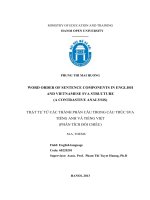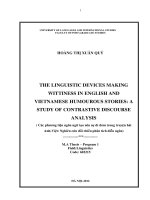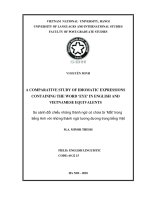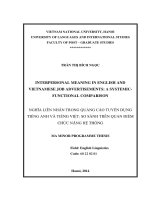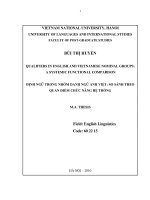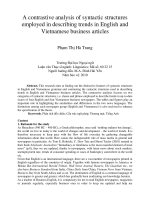Word order in english and vietnamese SVC structures (a constrastive analysis)
Bạn đang xem bản rút gọn của tài liệu. Xem và tải ngay bản đầy đủ của tài liệu tại đây (1.65 MB, 84 trang )
MINISTRY OF EDUCATION AND TRAINING
HANOI OPEN UNIVERSITY
-
TRAN THI HUONG
WORD ORDER IN ENGLISH AND VIETNAMESE
SVC STRUCTURES
(A contrastive analysis)
TRẬT TỰ TỪ TRONG CẤU TRÚC SVC
TIẾNG ANH VÀ TIẾNG VIỆT
(Phân tích đối chiếu)
M.A. THESIS
Field: English language
Code: 60220201
Supervisor: Pham Thi Tuyet Huong (Ph.D)
HANOI - 2013
DECLARATION
I hereby declare that no part of the enclosed Master Thesis has been copied or
reproduced by me from any other’s work without acknowledgement and that the
thesis is originally written by me under strict guidance of my supervisor.
Hanoi, 30 - 10 - 2013
Candidate
APPROVED BY
ACKNOWLEDGEMENTS
I owe deep gratitude to my supervisor: Ms. Pham Thi Tuyet Huong, (Ph.D)
whose endless guidance and insightful assistance helped me throughout the
writing of this research.
Additional thanks go to the students who actively participated in this study and
willingly shared their experiences with me.
My heartfelt thanks and a special debt of gratitude go to my family and my
friends for their love and support to a daughter, a friend whose mind was not
always free to give the attention they needed.
I would like to thank all people who took part in achieving this work.
TABLE OF CONTENTS
PART I: INTRODUCTION 1
1. Rationale of the study 1
2. Aims of the study 2
3. Research question 2
4. Scope of the study 3
5. Methods of the study 3
6. Design of the study 3
PART II: DEVELOPMENT 5
CHAPTER 1 5
THEORETICAL BACKGROUND 5
1.1.Review of the previous study 5
1.2. Theoretical background 9
1.2.1. Definition of word order 9
1.2.2. Definition of simple sentence 9
1.2.3. Basic English and Vietnamese simple sentence structure 10
1.2.3.1. Basic English simple sentence structure 10
1.2.3.2.Basic Vietnamese simple sentence structure 12
1.2.3.2. Summary 16
CHAPTER 2WORD ORDER IN ENGLISH AND VIETNAMESESVC
STRUCTURES 18
2.1. Word order in English SVC structures 18
2.1.1. English SVC structure 18
2.1.1.1. Syntactic features and semantic roles of Subject (S) 18
2.1.1.2. Syntactic features and semantic roles of intensive verb (V) 24
2.1.1.3. Syntactic features and semantic roles of Complement (C) 25
2.1.2. The variants of word order in English SVC structure 29
2.1.2.1. The variant of word order: CSV 29
2.1.2.2. The variant of word order: CVS 35
2.1.2.3. Summary 38
2.2.Word order in Vietnamese SVC structure 39
2.2.1. Vietnamese SVC structure 39
2.2.2. The variants of word order in Vietnamese SVC structure 42
2.3. The similarities and differences of word order between English and
Vietnamese SVC structure 43
2.3.1. The similarities of word order between English and Vietnamese
SVC structure 43
2.3.2. The differences of word order between English and Vietnamese
SVC structures 45
2.4.Summary 45
CHAPTER 3MAIN REASONS OF THE CHANGES OF WORD ORDER IN
ENGLISH AND VIETNAMESE SVC STRUCTURES 47
3.1. The speaker/writer wants to emphasize the topic of the sentence 47
3.2. The speaker/writer wants to express his/her feelings 50
3.3. The speaker/writer wants to give the cohesion of content in the discourse
54
3.4. Summary 57
CHAPTER 4IMPLICATION OF THE STUDY 59
4.1. Prediction of some types of errorsin the study of word order and causes of
these errors 59
4.1.1. Definition of error 59
4.1.2. Some mistakes of learners in translating English into Vietnamese and
vice versa 60
4.2. Some suggestions for learning and teaching word order in SVC structures
to Vietnamese students and teachers 64
4.3 Some suggested exercises for teaching word order to Vietnamese students
65
PART III: CONCLUSION 69
1. Recapitulation 69
2. Limitations of the study 71
3.Suggestions for a further study 72
REFERENCES 73
LIST OF ABBREVIATIONS
A = adverbial
Adj = adjective
C = complement
Cs = subject complement
Co = object complement
O = object
Od = direct object
Oi = indirect object
P = predicate
Ps = subject predicate
Po = Object predicate
S = subject
V = verb
Vintens = intensive V
PART I: INTRODUCTION
1. Rationale of the study
Nowadays, learning and teaching English play an essential role in
education and training. When we study any foreign language, the study of
grammatical structure in general and sentence structure in particular is very
important, no matter how much the rules change, as it is what makes it
possible for us all to communicate and understand what we see, and what we
say. The English language is made up of structures such as Subject – Verb –
Object, Subject – Verb – Complement, Subject – Verb – Indirect object –
Direct object, etc. Technically, one needs to know these structures in order to
write and speak English well.
In the study of grammar structure, the word order is universal concept
of linear structure in any analytical languages such as English. Word order in
general term is used in linguistics and literature to refer to the arrangement of
words in a given linguistic structure. It is one of grammatical means that
attracts the attention from many English linguists.
Moreover, the word order in English sentence structure in general and
SVC structure in particular is one of the most important parts in English
grammar. Beside word order, the reasons of the changes of word order in
English SVC structure have not been paid much attention to. And hence the
similarities and differences of word order in English and Vietnamese SVC
structures have not been written about.
In addition, word order in English sentence structure is a difficult topic
for teachers and students to teach and learn in English grammar. Therefore,
some teachers and students have omitted or have notprovided fully necessary
knowledge for this kind of structure. On the other hand, in process of teaching
English, we realize that Vietnamese students often make mistakes when using
the word order in English SVC structure. In order to overcome this situation
we need to distinguish the similarities and differences between English and
Vietnamese SVC structures. We hope the results of this study will help
learners write and speak both languages effectively; especially they will have
a good knowledge about word order of SVC structures.
For this reason, I would like to carry out my research on the topic:
WORD ORDER IN ENGLISH AND VIETNAMESE SVC STRUCTURES.
(A contrastive analysis)
2. Aims of the study
The main aims of the thesis are to:
• Present word order in English SVC structures and the main
reasons for the changes of word order.
• Present word order in Vietnamese SVC structures and the main
reasons for the changes of word order.
• Point out some similarities and differences between the word
order in English and Vietnamese SVC structures.
• Predict some errorsin the study of word order in English SVC
structures and give solutions.
• Give some suggestions in learning and teaching English SVC
structure including: How to learn and teach SVC structure and some
suggested exercises for teaching word order to Vietnamese learners.
3. Research question
• What are word orders of English and Vietnamese SVC
structures?
• What are the similarities and differences of word order between
English and Vietnamese SVC structures?
• What are the main reasons for the changes word order in English
and Vietnamese SVC structures?
• What are the common errorsof learners in using SVC structures?
• What are some suggestions for learning and teaching English and
Vietnamese SVC structures?
4. Scope of the study
The study focuses on SVC structures in both languages in simple
sentences. The basic word order and the changes of word order in English and
Vietnamese SVC structures will be presented in the examples of the literature
works from 19
th
century up to now.
5. Methods of the study
The main methods of this thesis are description, comparison and
contrastive analysis. The study will take English as the basic language and
Vietnamese is the language to be compared.
The data used for this study come from some English and Vietnamese
novels and poems. All the data are classified and organized in different
groups of their syntactic structure.
In addition, the translation exercises are chosen to identify what are
some errors of students in the studying of word order? The research is done
on more than 100 Hanoi Open University students to find the result.
6. Design of the study
This thesis is divided into three parts:
Part I: Introduction
This chapter provides an overview of the research by firstly presenting
rationale of the study, the aims and the research questions of the study. Then,
the scope of the study is pointed out. Next, the methods of the study and the
organization of the thesis are outlined.
Part II: Development (consists of four chapters)
Chapter 1: Theoretical background
This chapter provides a theoretical framework for the study of word
order in English and Vietnamese, including definitions of word order,
definition and types of basic English and Vietnamese simple sentence
structure in general and SVC structure in particular.
Chapter 2: Word order in English and Vietnamese SVC structures
The study will emphasize on the changes of word order in English and
Vietnamese SVC structures. The word order variations in SVC structures will
be found and analyzed in literature examples.
According to the word order variations, the study will analyze the
similarities and differences of word order between English and Vietnamese
SVC structures.
Chapter 3: Main reasons of the changes of word order in English
and Vietnamese SVC structures
The study will present some main reasons of the variants of word order
in English and Vietnamese SVC structures.
Chapter 4: Implications of the study
This chapter predicts some problems in the used of word order in SVC
structures and suggests some solutions and exercises for students and teachers
in learning and teaching English in general and word order in SVC structures
in particular.
Part III: Conclusion
This part will give a brief summary of the thesis and some main
conclusions of the thesis. It also includes the limitations and suggestions for
further study.
PART II: DEVELOPMENT
CHAPTER 1
THEORETICAL BACKGROUND
1.1. Review of the previous study
In some languages, word order is almost as important as the words used
in specifying meaning while other languages permit a wide variety
of word orders because the words themselves carry the most meaning. In
literature, words are ordered differently in different situations in order to
create a particular sound or rhythm, or to subtly alter the possible meaning of
a given phrase. Poets, in particular, must often manipulate word order to
achieve the desired rhyme and rhythm schemes. It has been an interesting
topic for study all over the world. In fact, word order has been dealt with by
many linguists in both English and Vietnamese.
Quirk. R & Greenbaum. S (1976) in A University Grammar of English
wrote about sentence components word order. They stated general rules about
the construction of sentences and pointed out five elements of a sentence:
Subject (S), Verb (V), Complement (C), Object (O) and Adverbial (A). In
basic order, the subject precedes the verb, the object follows the verb. The
indirect object always precedes the direct object. For example:
(1) He had given the girlan apple. (7: 13)
S V Oi Od
They presented seven basic sentence structures with their word order
including: SVA, SVC, SVO, SVOA, SVOC, SVOO, SV. They stated that:
“The order in which the elements appear is common but by no –means fixed.”
(7: 16)
Beside Quirk R & Greenbaum S (1976), Susan Steele(1976) in Word
order variation: A typological study research presented that “all languages
have a dominant word order, a surface ordering of subject, object and verb
relative to one another is at least more common than other possible
orders……. Most languages allow variations on their basic word order.” (9:
587). The author examined the word order variation in 63 languages all over
the world. The languages were selected with both genetic and typological
diversity. The research focused on main clauses – the word order of
constituents in a phrase and the order of morphemes in a word. The study
focused on declarative and non – declarative main clauses (questions and
imperative, etc.). Susan Steele examined the term variation in English
sentence with a topicalized Object noun. The author found that transitive
sentences involving more constituents have more variations in word order.
She examined in the SOV languages and found not only the basic order SOV
but also OSV, SVO, VSO and VOS. On the other hand, in SVO languagesshe
also found the word order variation including: VOS, VSO, SOV, and OSV.
Finally, in VSO languages she found some variations: VOS, SVO, OVS, and
OSV.
In addition, Laura Caballero Benito (2009) researched on topic:
Objective and Complement Fronting in the English Clause. The aims of the
study are to find Object and Complement fronting structures in contemporary
English and main pragmatic aspects in discourse. Construction of fronting is
one of word order variations. Benito divided the sentences in two groups:
Object fronting (2) and Complement fronting (3). For example:
(2) People I’ve known for years. (2: 28)
(3) Jack his name was anyhow. (2: 33)
The study also found that the Object fronting structures are more used
than Complement fronting structures.
In Vietnamese, many linguists paid a lot of attention to the word order.
For example, in the book “Ly thuyet ve trat tu tu trong cu phap” (2004), Ly
Toan Thang considered the word order theory in phrase, sentence and
utterance. He researched the function of word order not only in syntactic but
also in semantic and pragmatic features.
Le Quang Thiem (2008) with the book “Nghien cuu đoi chieu cac ngon
ngu” presented the contrastive analysis between English and Vietnamese
sentence components. He pointed out the similarities and differences between
two languages. English and Vietnamese sentence has four elements which are
similar including: Subject, Verb, Object, Adverb and Complement. In
addition, Vietnamese sentence has two elements: Theme and modality which
are not in English.
In addition to the study of word order, there are a number of authors
studying about word order such as: Pham Thi Tuyet Huong (2001) studied on
the word order in English and Vietnamese verb phrases. She carried out a
contrastive analysis in the syntactic aspect. English is the basic language and
Vietnamese is the language to be compared. The thesis gave a systemic
description of the word order in English and Vietnamese Verb phrases. For
example, in English Verb phrases preceding elements are auxiliary verbs.
These verbs have certain order without any changes. Following elements of
English Verb phrase are complicated. They have open structures. They can be
a noun, an adjective, an infinitive, an adverb etc. After describing the word
order in English and Vietnamese verb phrase, the thesis found some main
similarities and differences between them and gave some suggestions for
teaching and learning languages.
According to Nguyen Thi Quynh Hoa (2004) with Doctoral thesis:
“Structure and Meaning in English Inversion versus Vietnamese”, the nature
of English inversion on the domains of syntax, semantics and pragmatics was
classified. The thesis studied English inversion in declarative sentences. The
thesis emphasized on the word order in types of inversion in both languages.
Beside the thesis showed the similarities and differences between inversions
in English and Vietnamese. The study found that in both languages there is a
similarity in “Prepositional phrase + Verb + Noun Phrase”. In English and
Vietnamese sentences, the initial position plays an important role in emphasis
and cohesion. On the other hand, the difference between two languages is on
the syntactic structures and the role in sentence components. The thesis
systematizes the patterns of the inversion in English declarative sentences and
also examined three functions of English inversion: the presentational
function, the emphatic function, and the cohesive function. Inversion is a
syntax process and it makes the changes of word order in a sentence. In her
thesis, the change of word order in SVC structure in full inversion into CVS
structure was presented.
Generally, most of studies in English and Vietnamese are only
investigations into the word order in general or in SVO, verb phrases, or
inversion particularly. Although considerable research has been devoted to the
study of word order in English and Vietnamese sentence structure, less
attention has been to the variants in word order of SVC structure. In this
thesis I would like to study the word order in English SVC structure more
deeply. It is hope that what comes out of this study might provide useful
practical knowledge for teachers and learners of English.
1.2. Theoretical background
1.2.1. Definition of word order
A points out that word
order is the way in which words are arranged in sequence in a sentence or
smaller construction.
Word order refers to the study of the order of the syntactic constituents
of a language. (
According to Greenbaum, S. (1996), “Word order is the order of
constituents within a phrase, clause, or sentence. For example, in a declarative
sentencethe normal word order is subject, verb, directobject: All the workers
(subject) have signed (verb) the petition (direct object).” (4: 635)
Ly Toan Thang (2004) stated that word order is not only in words but
also in word – formation (morpheme and sound) in compound word. For
examples: comparing: vợ chồng – chồng vợ, ông cha – cha ông, etc. On the
other hand, word order is also in a group of words. For example: comparing:
róc rách chảy – chảy róc rách. Finally, word order is the order of clause in
compound sentence. For example: comparing:
Nếu trời không mưa thì tôi sẽ đi.
Tôi sẽ đi, nếu trời không mưa. (25: 8)
1.2.2. Definition of simple sentence
A Sentence is a grammatical unit of one or more words that expresses
an independent statement, question, request, command, exclamation, etc.
(
According to Quirk, R & Greenbaum, S(1985) “A simple sentence
consists of a single independent clause.” (8: 719)
Greenbaum, S. (1996) defined that “A simple sentence consists of one
main clause, without any subordinate clauses: No fingerprints were found
anywhere in the house.” (4: 632)
According to Diep Quang Ban (1998, 2011), A sentence is the
language unit which has independent inner and outer grammatical structure
and ending intonation. It bears a relatively complete thought or the speaker’s
attitude, or only displaying the speaker’s attitude, which helps form, show
and communicate ideas and affection. A sentence is the smallest information
unit. (11: 106)
1.2.3. Basic English and Vietnamese simple sentence structure
1.2.3.1. Basic English simple sentence structure
Traditionally, sentences have been divided into two parts: Subject and
Predicate. The predicate includes verb and its complements.For example:
(4) John carefully searched the room. (7:10)
Subject Predicate
Nowadays, there are many theories about sentence structure. Modern
English divides sentence with many components. According to Quirk, R. and
Greenbaum, S. (1976), the elements of sentence structure include five units:
Subject (S), Verb (V), Complement (C), Object (O) and Adverbial (A). And
there are three kinds of sentence: simple, compound and complex. All the
kinds can be analyzed in terms of S, V, O, C and A. They stated seven basic
sentence types:
- SVA
(5)Marry is in the house. (7:167)
S V(intens.) A(place)
- SVC
(6)Marry is kind. (7:167)
S V(intens.) Cs
- SVO
(7)Somebody caught the ball. (7:167)
S V(mono trans.) Od
- SVOA
(8)I put the plate on the table. (7:167)
S V(complex trans.) Od A(place)
- SVOC
(9) We have proved him wrong. (7:167)
S V(complex trans.) Od Co
- SVOO
(10)She gives me expensive presents. (7:167)
S V(distrans.) Oi Od
- SV
(11)The child laughed. (7:167)
S V(intrans.)
According to Greenbaum, S (1996), “A sentence consisting of just one
clause is a simple sentence.” He pointed out five elements of sentence
structure including: Subject (S), Verb (V), Object (O), Predicative (P), and
Adverbials (A) – which is optional constituent of the sentence. They
encountered five basic sentence structures:
- SV
(12)My glasses have disappeared. (4: 71)
S V
- SVO
(13)Our country is absorbing many refugees. (4: 71)
S V O
- SVOO
(14) I am sending you an official letter of complaint. (4: 71)
S V Oi Od
- SVP
(15)The water-bed was very comfortable. (4: 71)
S V Ps (Subject Predicative)
- SVOP
(16)I have made my position clear. (4: 71)
S V Od Po (Object Predicative)
In this thesis, we will use the word order theory in sentence structure of
Quirk, R. and Greenbaum, S. (1976) because the seven sentence structures are
suitable with sentence types in Vietnamese. In detail, the thesis will study on
word order in English and Vietnamese SVC sentence structures.
1.2.3.2.Basic Vietnamese simple sentence structure
In Vietnamese, there are some linguists who study sentence
components deeply such as: Diep Quang Ban, Hoang Trong Phien, Nguyen
Minh Thuyet and Cao Xuan Hao, etc. According to Nguyen Minh Thuyet and
Nguyen Van Hiep (2004) Vietnamese sentence has main components and
sub- components. The main component includes: Subject (S), predicate (V)
and Object (O). For example:
(17) Anh ấy 30 tuổi.
S
(18) Nó tên là Quýt.
V
(19) Cảnh sát đã bắt tên trộm.
O
Beside the main components, Vietnamese sentence also has sub-
components including:
- Theme complement. For example:
(20) Gã tình nhân vô liêm sỉ ấy, Từ đã yêu hắn bằng cả tấm lòng yêu
lúc ban đầu.
- Modal phrase. For example:
(21)Cô nên vào trong nhà thì hơn.
- Attribute. For example:
(22) Đằng thằng ra, người khác chỉ học có ba năm.
- Adverbial. For example:
(23) Chị nhịn ăn đã hai ngày.
Nguyen Minh Thuyet also presents kinds of basic sentence
components. He divided its kind into syntax structure and the representative
function for whole sentence. The division is shown in the table below.
1. Syntax
structure
- Basic one component sentence (which
has only one immediate constituents) (IC)
(24) Example: “Mưa!”
- Basic two - component sentence
(Which has two IC)
+ Simple basic two - component sentence.
(25) Example: “Tôi / đọc sách.”
+ Complex basic two component sentence.
(26) Example: “Nếu trời mưa / thì tôi đọc
sách.”
2. The
representative function
for whole sentence.
- Simple basic one component sentence
(27) Example: “Sáng chủ nhật mưa.”
- Complex basic one component
component
(28) Example: “Buổi chiều, nắng vừa
nhạt, sương đã buông khắp mặt biển.”
Nguyen Minh Thuyet (2004)
According to Panfilov. V.S. (2008), the division of Vietnamese simple
sentences according to their morphology and semantics is based on the
division of predicative groups and their ways of expression. And this divison
is carried out with the first word order of sentence (23: 359). He divided into
six kinds of Vietnamese simple sentence structures as the table below:
Simple sentence structures Examples
1. Intransitive structure
expresses the state of subject. The
predicative group is ended by
predicator.
(29) Nó ngủ
(30) Trong hầm vắng vẻ.
2. Transitive structure
expresses interaction of subject and
object. The predicate group is
expressed by a noun phrase.
(31) Nó xây nhà.
(32) Tôi tìm người quen.
3. Existencial structure
expresses the things which the subject
cannot control. The predicative group
(33) Nó hết tiền.
(34) Cây rừng trọi lá.
is expressed by group of predicate.
4. Structure expresses
career with copular verb “là”.
(35) Nó là sinh viên.
(36) Dệt là nghề của tôi.
5. Structure expresses
quantitative meaning. The predicate
has a set of numbers.
(37) Nó hai mươi tuổi.
(38) Thời gian học là 18
tháng.
6. Strucuture expresses
positioning meaning. The predicate
includes location words.
(39) Bố tôi ngoài vườn.
(40) Anh ta trong đội du kích
xã.
Panfilov. V.S. (2008)
In “Ngữ pháp Việt Nam – phần câu” (2009), Diep Quang Ban divided
declarative sentence into twelve kinds of sentence. The groups depend on
clause syntactic structure and state of affairs of sentence components in
Vietnamese. Twelve kinds of sentence are divided into two main groups:
sentence has subject and sentence has no subject.
a) Sentence has subject
- Sentence with verbal, adjectival, and nominal meaning.For
example:
(41) Bà Hai đi chợ.
(42) Trăng sáng quá.
(43) Anh này kĩ sư đấy.
- Sentence with dependent, relative words; copular verb “là”,
prepositions such as tại, bởi, do, etc.For example:
(44) Cầu thủ giỏi nhất ở đây là người này.
(45) Việc này tại Giáp.
(46) Bài thơ này do một bạn thơ trẻ làm.
- Causative sentence. For example:
(47) Bão đổ cây.
- Subjunctive sentence. For example:
(48) Giám đốc buộc nó nghỉ việc.
- Sentence with subject – instrument. For example:
(49) Giấy này in báo.
- The whole – part components sentence. For example:
(50) Cây này vàng lá.
- Sentence with inversion structure. For example:
(51) Thùng đầy nước Nước đầy thùng.
- Sentence with theme component. For example:
(52) Tôi thì tôi xin chịu.
- Passive sentence. For example:
(53) Tranh được chủ nhà treo đầy tường.
b) Sentence has no subject
- Existencial sentence. For example:
(54) Trên tường treo mấy bức tranh.
- Vocatives. For example:
(55) Anh em ơi! Bất chấp gian nguy…
(56) Em gì ấy ơi!
(57) Sen đâu?
(58) Dạ.
- Exclamation. For example:
(59) Chà ! Cỗ to đấy nhỉ? Đằng ấy hóa ra lại …bở!
1.2.3.2. Summary
After studying Vietnamese sentence theory of some linguists, we found
that:
- Vietnamese is anisolated and non-inflectional language.
- Word order and functional grammatical words have an important
role in making Vietnamese sentence.
- Word order in Vietnamese sentence is very strict, but the word
order can be changed. It depends on the intentions of speakers or writers.
According to the classification, we give out the similar structure of
SVC sentence in English and Vietnamese. In English, the role of subject
complement is attribution of the subject. The verb is copula. For example:
(60) She is beautiful.
Therefore, the English SVC structures which are similar to Vietnamese
sentences include:
- Basis two - component sentence has adjective predicate. (with
copula or not). For example:
(61) Sống trong cảnh giàu sang chắc chắn, Tâm không bao giờ nghĩ
đến quê nhà nữa. Hoặc có nghĩ đến, chỉ để lại tự chế giễu mình. Khi còn nhỏ,
đã cho cái đời ở thôn quê là giản dị và sung sướng. (36: 23)
- Basic two component sentence with nominal predicate. (with
copula or not). For example:
(62) Nó sẽ còn chà nhiều trận nữa chớ. Tụi nó dư biết đấy là căn cứ
của mình. Nó biết mọi cuộc đấu tranh tràn vô thị xã đều xuất phát từ đây. Vả
lại, Hòn Đất là một điểm nằm trong khu vực tập trận của khối xâm lược
Đông
S V C Nam A.(33:
18)
- Sentence expresses career with copula “là”. For example:
(63) Vợ anh là con bác khan thủ làng trên. Anh là phu tuần. Hai
người lấy
S V C
nhau, cả hai làng, ai cũng khen là vợ chồng kén chọn được chỗ xứng
đáng. (34: 133)
CHAPTER 2
WORD ORDER IN ENGLISH AND VIETNAMESE
SVC STRUCTURES
2.1. Word order in English SVC structures
2.1.1. English SVC structure
In English, SVC is one of seven basic sentence structures. In this
structure, the complement is subject complement. According to Quirk, R. and
Greenbaum, S. (1976, 1985), subject complement is in a copula relationship
with the subject and the verb is copula.
(64) For example: His brother grew happier gradually.
S V C
In this chapter, the thesis will present the syntactic features and
semantic roles of sentence components in SVC structure.
2.1.1.1. Syntactic features and semantic roles of Subject (S)
2.1.1.1.1. The form of subject
According to Quirk, R. and Greenbaum, S. (1976, 1985), Subject is the
most important component in a sentence. The subject can be a Noun phrase
(NP) in simple sentence or Nominal Clause (NCL) in complex sentence.
“A Noun phrase has as its head a noun, a pronoun, a nominal adjective
or a numeral.” (4:221). Greenbaum (1996) states that a noun phrase has a
noun as a head which is often introduced by article (a, an, the, and Ø) and
other determiners. A noun phrase also has modifier (pre - modification and
post – modification) which add information for the head. Subject is one of
functions of noun phrase. Other functions of noun phrase such as: direct
object, indirect object, subject complement, object complement, etc. For
example:
- Basic noun phrase:
(65) The book . (23:19)
Determiner Head noun
(Definite article) (Countable noun)
(66) Double your salary. (23:19)
Pre-determiner Determiner Head noun
(Multipliers) (Possessive) (Noun)
- Complex noun phrase:
(67) The pretty blackish girl who you met on the way here. (23:
32)
Pre – modification Head Post – modification
Adjective Clause
- Noun phrase function as a Subject:
(68) The pretty girl who became angry is Mary Smith. (7: 59)
“Nominal clause can have a range of functions similar to those of noun
phrase.” (4: 330) According to Quirk, R. and Greenbaum, S. (1976) nominal
